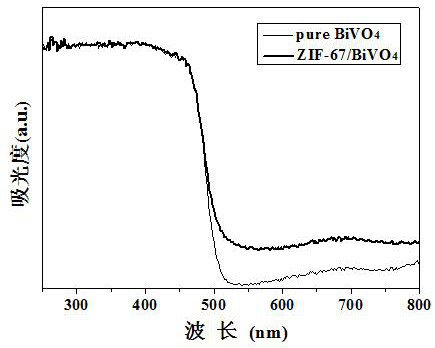Preparation of a zif-67/bismuth vanadate composite and its application as a photoanode material
A ZIF-67, composite technology, applied in electrodes, electrolysis components, electrolysis processes, etc., can solve problems such as MOF stability limitations
- Summary
- Abstract
- Description
- Claims
- Application Information
AI Technical Summary
Problems solved by technology
Method used
Image
Examples
Embodiment Construction
[0027] The preparation of the ZIF-67 / BiVO4 composite material of the present invention and its application as a photoanode in water splitting and hydrogen production will be further described below through specific examples.
[0028] (1) Preparation of BiVO4: It was prepared according to the method of electrodeposition combined with heat treatment by Kim and Choi's research group. Specific steps: firstly, BiOI nanosheets were prepared by electrodeposition using CHI 660D electrochemical workstation. FTO glass cleaned ultrasonically with acetone / isopropanol / distilled water (volume ratio: 1:1:1) was used as the working electrode, the Ag / AgCl (3.5 M KCl) electrode was used as the reference electrode, and the Pt electrode was used as the counter electrode. with 6M HNO 3 Adjust the pH of 50 mL0.4 M KI solution to 1.5~1.7, then add 0.970g Bi(NO 3 ) 3 • 5H 2 O until dissolved and the solution color changed to orange-red. Then slowly add 20ml 0.498 g 1,4-benzoquinone ethanol solut...
PUM
 Login to View More
Login to View More Abstract
Description
Claims
Application Information
 Login to View More
Login to View More - R&D
- Intellectual Property
- Life Sciences
- Materials
- Tech Scout
- Unparalleled Data Quality
- Higher Quality Content
- 60% Fewer Hallucinations
Browse by: Latest US Patents, China's latest patents, Technical Efficacy Thesaurus, Application Domain, Technology Topic, Popular Technical Reports.
© 2025 PatSnap. All rights reserved.Legal|Privacy policy|Modern Slavery Act Transparency Statement|Sitemap|About US| Contact US: help@patsnap.com



